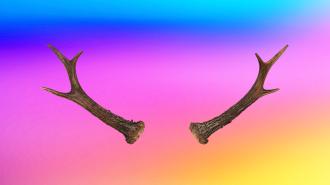Scientists in China have identified a new type of stem cell, which enables deer to regenerate their antlers year after year. When transplanted into mice, the rodents grew mini antlers, too, suggesting that the cells could trigger regeneration in other mammals — potentially even humans.
The challenge: All living creatures have some regenerative abilities, but they’re extremely limited in mammals — while starfish and lizards can grow entire limbs, for example, the best mice can do are the tips of certain digits.
Deer are a notable exception. Every year, they grow and shed a set of antlers: the only example of a mammal repeatedly regenerating an entire appendage. The process is fast, too, with the bony structures growing as quickly as an inch a day.
Within 45 days of the surgery, the mice grew antler-like bumps containing cartilage and bone.
The discovery: In an attempt to learn more about the remarkable regeneration of deer antlers, scientists at Northwestern Polytechnical University in China used RNA sequencing to examine thousands of deer cells at various stages of the antler growth and shedding cycle.
By mapping antler regeneration on a cellular level, the researchers discovered that a previously unidentified family of stem cells is essential to the process. They call these cells “antler blastema progenitor cells” (ABPCs) and detail their discovery in a newly published paper.
The experiment: Once they had identified ABPCs, the researchers isolated some of the cells and performed a number of experiments on them in petri dishes, looking at how the cells could differentiate into bone and cartilage.
They also performed an experiment in mice, inserting stem cells taken from deer antlers into the rodents’ skulls. (These weren’t ABPCs but, one step further back, the stem cells that would later become them: PRRX1+ mesenchymal cells).
Within 45 days of the surgery, the mice grew antler-like bumps containing cartilage and bone under the skin of their skulls. (This is not the first time scientists have grown antlers in mice — another team from China did so in 2020 by implanting deer tissue under the rodents’ skull skin.)
Why it matters: During their research, the scientists also discovered that mice already have a type of cell similar to the ABPCs in deer antlers in the digit tips they can regenerate, but not the ones they can’t.
They didn’t find anything like the cells in axolotls and zebrafish — two non-mammals capable of regeneration — either, suggesting that these kinds of cells are unique to mammals.
While this is still very early research, the scientists think it may be possible to use deer ABPCs, or similar cells developed from human stem cells, to regenerate bone in people. This could potentially give us a better way to repair skeletal injuries — and maybe even help us to regrow our own limbs one day.
We’d love to hear from you! If you have a comment about this article or if you have a tip for a future Freethink story, please email us at tips@freethink.com.
